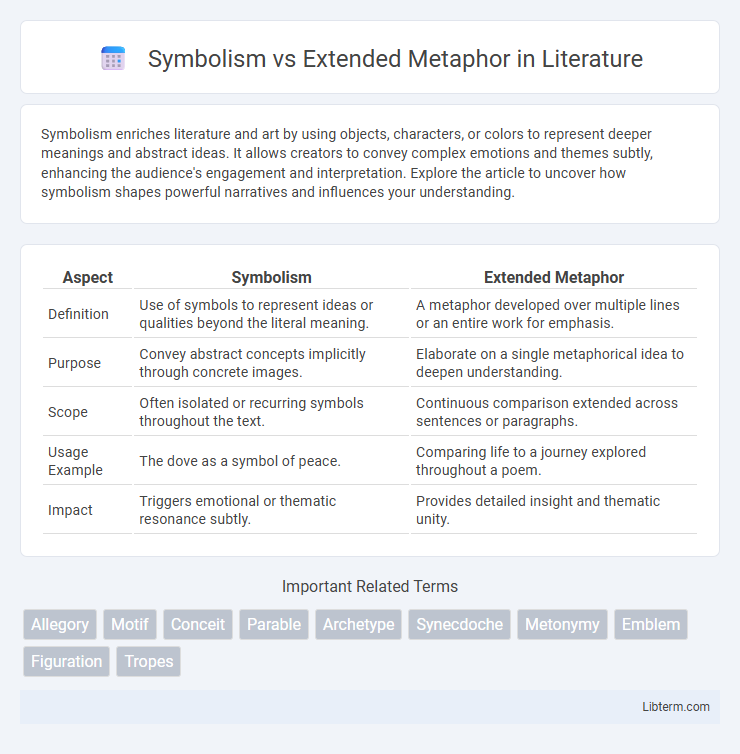Symbolism enriches literature and art by using objects, characters, or colors to represent deeper meanings and abstract ideas. It allows creators to convey complex emotions and themes subtly, enhancing the audience's engagement and interpretation. Explore the article to uncover how symbolism shapes powerful narratives and influences your understanding.
Table of Comparison
| Aspect | Symbolism | Extended Metaphor |
|---|---|---|
| Definition | Use of symbols to represent ideas or qualities beyond the literal meaning. | A metaphor developed over multiple lines or an entire work for emphasis. |
| Purpose | Convey abstract concepts implicitly through concrete images. | Elaborate on a single metaphorical idea to deepen understanding. |
| Scope | Often isolated or recurring symbols throughout the text. | Continuous comparison extended across sentences or paragraphs. |
| Usage Example | The dove as a symbol of peace. | Comparing life to a journey explored throughout a poem. |
| Impact | Triggers emotional or thematic resonance subtly. | Provides detailed insight and thematic unity. |
Understanding Symbolism: A Literary Foundation
Symbolism in literature involves using objects, characters, or events to represent broader ideas and themes, creating deeper layers of meaning beyond the literal narrative. Understanding symbolism requires recognizing how symbols function as tangible signs that evoke abstract concepts, enriching the textual experience. This foundational knowledge enhances interpretation by revealing the intricate connections between the symbol and the author's intended message.
Defining Extended Metaphor in Literature
Extended metaphor in literature is a sustained comparison between two unlike things throughout a poem, story, or novel, enriching the narrative by adding deeper meaning and layers of interpretation. Unlike symbolism, which uses a single symbol to represent a broader idea, extended metaphor develops the analogy over multiple lines or passages, creating a more complex and nuanced understanding. This technique enhances thematic exploration and emotional resonance by weaving the metaphor into various elements of the work.
Key Differences Between Symbolism and Extended Metaphor
Symbolism uses symbols to represent ideas or qualities, often carrying deeper meanings beyond the literal sense, while extended metaphor is a sustained comparison throughout a text that elaborates on a single metaphorical concept. Symbolism can appear as objects, characters, or colors symbolizing abstract themes, whereas extended metaphor develops a complex analogy that shapes the entire narrative or argument. Key differences include symbolism's broad application to evoke multiple interpretations versus extended metaphor's focused, continuous exploration of one metaphorical idea.
The Purpose and Power of Symbolism
Symbolism conveys complex ideas and emotions through objects, characters, or colors that represent broader concepts, enabling deeper layers of meaning in literature and art. The power of symbolism lies in its ability to evoke universal experiences and provoke thought by connecting tangible elements with abstract themes, enhancing reader engagement. Unlike extended metaphors, which explicitly develop a single comparison throughout a text, symbolism operates more subtly, allowing multiple interpretations and enriching narrative depth.
Functions of Extended Metaphor in Storytelling
Extended metaphor functions in storytelling by creating a sustained comparison that deepens thematic complexity and enriches character development across the narrative. Unlike symbolism, which uses a single object or image to represent an idea, extended metaphors weave a continuous thread of meaning, reinforcing the story's underlying messages and emotional resonance. This technique engages readers by encouraging them to explore layered interpretations, making the narrative more immersive and thought-provoking.
Examples of Symbolism in Classic and Modern Works
Symbolism often appears in classic literature through objects like the green light in F. Scott Fitzgerald's *The Great Gatsby*, representing unreachable dreams and the American Dream's decay. Modern works use symbols such as the mockingbird in Harper Lee's *To Kill a Mockingbird* to embody innocence and moral integrity. Unlike extended metaphors, which unfold a single figurative comparison throughout a narrative, symbolism relies on recurring images or motifs to convey complex themes and emotions within a text.
Famous Extended Metaphors in Literature
Famous extended metaphors in literature, such as Shakespeare's "All the world's a stage" in *As You Like It*, use a single, continuous metaphor to develop complex ideas about life and human behavior throughout a work. Unlike symbolism, which uses objects or elements to represent broader concepts, extended metaphors unfold progressively, deepening thematic impact over multiple lines or passages. John Donne's comparison of lovers to a compass in his poem "A Valediction: Forbidding Mourning" exemplifies how extended metaphors intricately weave intellectual and emotional meaning.
How Writers Choose Between Symbolism and Extended Metaphor
Writers choose symbolism when they want to suggest broader meanings through objects, colors, or actions that represent abstract ideas, allowing readers to interpret layers of significance. Extended metaphors are preferred when authors need to develop a sustained comparison across multiple lines or paragraphs, providing a cohesive and detailed exploration of a concept. The decision hinges on whether the writer aims for subtle, open-ended implications or a clear, elaborated analogy that drives the narrative or argument forward.
Effects on Readers: Symbolism vs. Extended Metaphor
Symbolism evokes deeper emotional responses by allowing readers to interpret multiple layers of meaning, enriching the text's thematic complexity. Extended metaphors sustain a singular, vivid comparison throughout a passage, enhancing clarity and providing a focused framework for understanding abstract concepts. Both techniques engage readers cognitively and emotionally, but symbolism fosters open-ended interpretation while extended metaphors guide readers toward a specific insight.
Mastering Both Devices: Tips for Effective Usage
Mastering symbolism and extended metaphor requires understanding their distinct roles: symbolism represents broader concepts through objects or actions, while extended metaphor unfolds a detailed comparison throughout a narrative or poem. Effective usage involves consistent thematic reinforcement, ensuring symbols resonate emotionally and extended metaphors maintain clarity without overstating. Writers should balance subtlety and explicitness, using concrete imagery to deepen meaning and engage readers on multiple interpretive levels.
Symbolism Infographic

 libterm.com
libterm.com